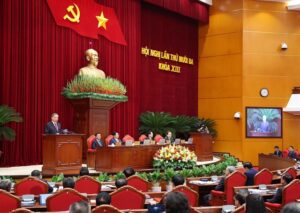The Thap Doi Twin Towers: A Glimpse into Cham Architectural Heritage

Located around 350 meters inland from the last bend of the Ha Thanh River, ahead of its merging in to the Thi Nai swamp, the Thap Doi Twin Towers are a symbol of the socio-cultural architectural era of the Chams. These towers are located just within the region of today’s Quy Nhon, which is therefore the nearest Cham architecture that this city can boast.
The Thap Doi towers were built in the late 12th or early 13th century and are characterised by clearly recognisable Khmer features. As for most Cham towers, each building was built with one door facing east. Still, the towers, extend about 3 km inland from the ocean and are only 4 meters above sea level, have survived time and the forces of nature in a very good way. The distinctive, spherical upperworks are all heavy on the bow, but they’ve weathered storm surge and the cofilm salt.
When it was first built, the site contained three rows of towers, connected by a zigzag pattern of lanes; nowadays, however, only two rows of towers are left. The first tower to the north, which was the nearest to Ha Thanh River, was the first to collapse in the 19th century. Another tower, which rose in this area, did not survive and after its ruins were removed, overgrown with vegetation.
From the surviving structures, the central tower is relatively well preserved hence can be considered as a major landmark. Its rehabilitation was started in the 1960s but had to cease due to being in the middle of the prevailing conflict. Limited work was again undertaken in the 1990s, with dedicated work put into the restoration of the roofs of the towers. The roof of the central tower has been refurbished between 1990 and 1995 with the greatest care. The approach to restoration was, therefore, conservative; for instance, figures that had been missing and which formed part of decorations such as cornice friezes were carved in sandstone similar in colour to the raw material used for the rest of the structures Visitors can identify a difference between the original and the restored parts.
The staples of the towers’ design are great; there is a frieze of monkeys that runs around the lowermost cornice and ends at the Garuda figures that are in a projecting angle. Though the effects of long exposure to salt spray are easily detected, the friezes that have survived the test are not in too bad a state. The metopes of diminishing tiers of the brickwork are on the roofs of the towers that recreates the entrances of small temples. As they initially stood, each face of these tiers was topped by a sandstone figure of a cross-legged man in prayer; nearly all of these sculptures have since been destroyed and are now replaced by plain stonework imitative of their lost original.
The roof of the south tower was secured against further collapse but the restoration of this structure was confined compared to the central tower. Therefore, one is able to see the roof as it was before the modern restoration work was commenced.
In the sanctum sanctorum, which is in the middle of the circular plan, a lingam-yoni has been installed; this is however, a modern addition and not an original feature of the monument. It is still uncertain which of the deities the Cham people worshipped at the site was their main deity. Thus, the meanings that are carved on the sandstone doorjambs from which inscriptions are exhibited in Binh Dinh Museum were supposed to reveal the temple’s history and the deities residing there, but they remain inconclusive.
More can be seen in the Binh Dinh Museum where fragments of the towers preserved in relatively good condition such as the frieze of dancers and the doorjambs can be observed. These artifacts help to relate with the artistic as well as the religious life of the Cham people and opens up a new dimension that offers an insight into the rich cultural heritage that is still being preserved.


